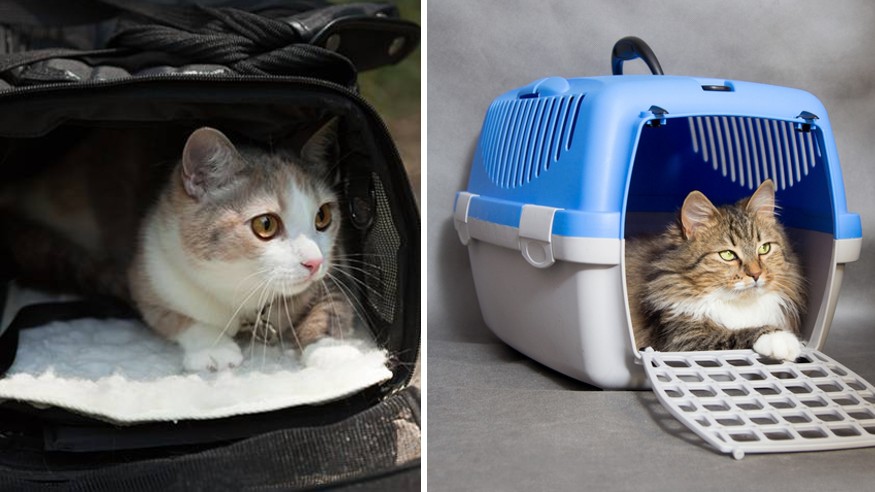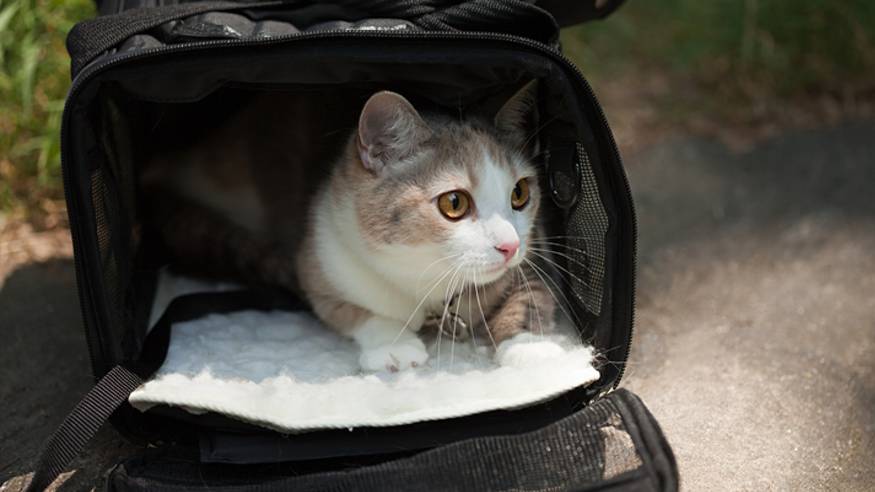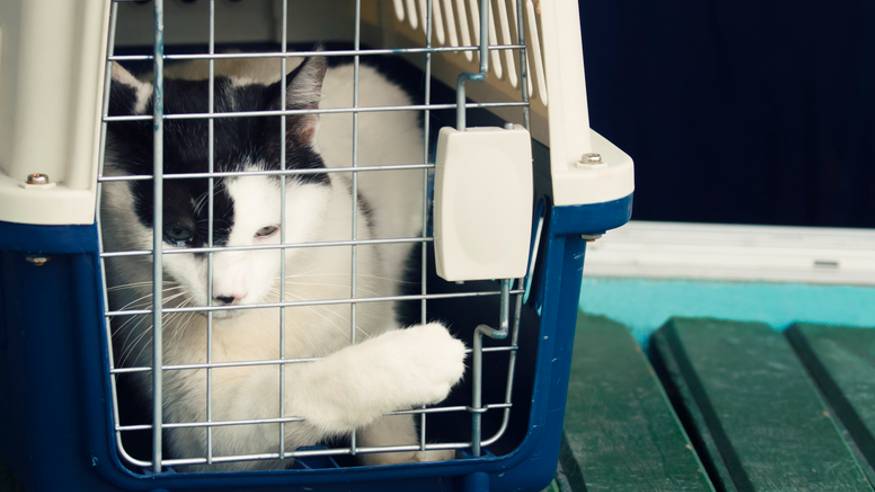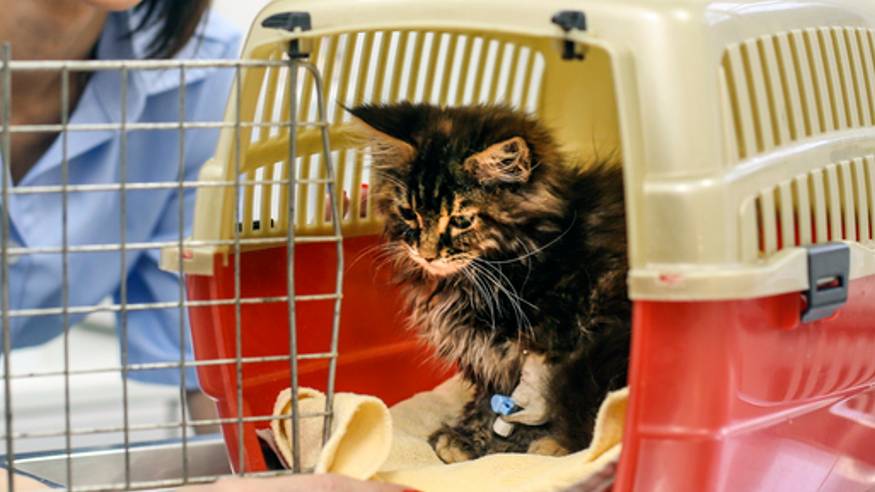Soft vs hard cat carrier: which to choose?
If you’re thinking about transporting your beloved cat, then our guide will help you decide between the merits of a soft vs hard cat carrier

Sometimes even the most home loving kitty needs to leave the house. Whether it’s for a trip to the veterinarian or to move house, it’s always useful to have a robust cat carrier on hand that your cat feels comfortable in.
Should you choose a soft or hard cat carrier, though? Both have points in their favor, so read on to find out how you should invest your hard-earned cash.
What is a soft carrier?
As the name suggests, these are non-rigid, squashy carriers. They’re generally made from a tough material such as nylon and normally have mesh panels for ventilation. You can buy top of the range designer leather versions, or cheaper value options depending on budget.

Types of soft carrier
Soft cat carriers vary more than the hard, rigid kind, so it’s worth considering how you’ll use your carrier. Choose from:
- Backpacks Yes, really! If you like, you can wear your cat on your back. Some cats love these, as it enables them to feel close to you while being able to see what’s going on all around them. Shyer cats may hate them, as they can feel overwhelmed. They can be useful for carrying your pet longer distances, such as travelling through an airport.
- Tote bags These cat carriers can be surprisingly stylish and can look like ‘normal’ tote bags. They generally come with both shoulder straps and carry handles and one or more zippered doors.
- Body slings These are neat carriers that pass over your body and cradle your cat close to you. Many cats like them, as their body is secure and supported but they can still see out. They’re not as secure as zippered carriers so may not be suitable for very energetic kitties! As they enable you to carry your cat in front of you rather than on your back, you’re better able to reassure and cuddle her.
Pros and cons of soft carriers
One of the main advantages of soft carriers is that they’re less bulky to store than the rigid kind, which is great if you’re tight on space. They’re also lighter and easier to carry as you can put them over your shoulder. Many airlines also allow them on as hand luggage.
On the downside, some cats may not feel as secure in them and they’re more liable to claw damage. As the doors are soft, a determined cat can push her way out before you can pull the zipper closed. They’re also not as easy to clean if your kitty is prone to car sickness.
What is a hard carrier?
Hard carriers look completely different to their soft counterparts, and are rigid boxes normally made of tough plastic. They have one or more doors, generally covered with a metal or plastic mesh. You can also buy traditional pet carriers made of willow.

Types of hard carrier
Hard carriers tend to all look very similar but can come with different features. Most have one door at the front, but some have top doors and others have both top and front. Other features may include clip-on food and water bowls for longer journeys.
Pros and cons of hard carriers
On the whole, hard carriers are more robust and secure for your cat. As such, they’re better for long journeys and they tend to be larger and more spacious than soft carriers. As the doors are rigid your cat will find it harder to escape as she’s put in and harder to break out as well – great if you have a feline Houdini.
On the other hand, this type of carrier tends to be more expensive to buy and bulkier to store. They’re also not as cozy so cats that like nesting may not find them as comfortable.
How to make a cat carrier more comfortable
That leads us neatly onto our next point: what can you do to improve kitty’s comfort? We need to consider both her mental and physical wellbeing.
To reduce stress and make sure she’s relaxed, familiarize her with her new carrier well before you need to use it. Putting in a familiar blanket with her scent on and using a pheromone spray may also help. We’ve got more advice on how to get your cat into a cat carrier here.
In regards to physical comfort, hard carriers will need more padding than soft versions. Some cats like lots of bedding as they like to snuggle and hide. Whatever you use should be pet-friendly and easy to clean.

How to choose the best cat carrier
When you’re deciding whether to buy a soft vs hard cat carrier, there are several things to think about.
- Size The size of the carrier should be just larger than your pet. Cats can slide around in too-large carriers and may feel insecure. As long as your cat has room to sit, lie, stand and turn around that’s all you need. For more detailed advice on how big a cat carrier should be, see our guide.
- Weight Are you going to have to carry your cat around for long periods? If so, consider a carrier that’s light and easy to transport.
- Closures What you go for here depends entirely on your cat! If she’s a laid-back soul, then a zippered door will be fine. If she’s young, nervous or has a bit of a sense of humor, you may be better with a hard carrier with two doors, a top one and a front one. Some carriers unhinge so that you can lift the top off and leave your cat sitting in the base. If you’re travelling, this can double as a cat bed.
- Maintenance and storage Most cat owners don’t use their carriers very often. If yours spends more time on the shelf than in use, look for something that’s easy to store and quick to clean.
- Safety Some cats prefer a hard carrier to a soft one, as it feels more secure to them. Any carrier you use should be in good repair with no holes or damage, and regularly cleaned.
The best cat carrier should be one that suits your needs and that your cat feels comfortable travelling in.
Is it better to have a hard or soft cat carrier?
Now that you’ve heard the arguments on soft vs hard cat carriers, you’ll know that your choice is partly down to personal preference and partly down to what your cat prefers.
Although it’s possible to transport a cat safely without using a carrier at all, carriers are normally the safest choice for most journeys. Your kitty should arrive at her destination calm, comfortable and at ease – in fact, she may be more chilled than you are!
PetsRadar Newsletter
Get the best advice, tips and top tech for your beloved Pets
Sara is a freelance journalist and copywriter of many years’ experience with a lifelong love of animals. She’s written for a range of magazines and websites on subjects varying from pet care to travel. A horse rider since the age of five, she’s currently a full time pet slave to horse Blue and gorgeous, goofy English Springer Spaniel Olly. Adorable Olly has a huge sense of adventure and no sense of direction, keeping Sara on her toes.

